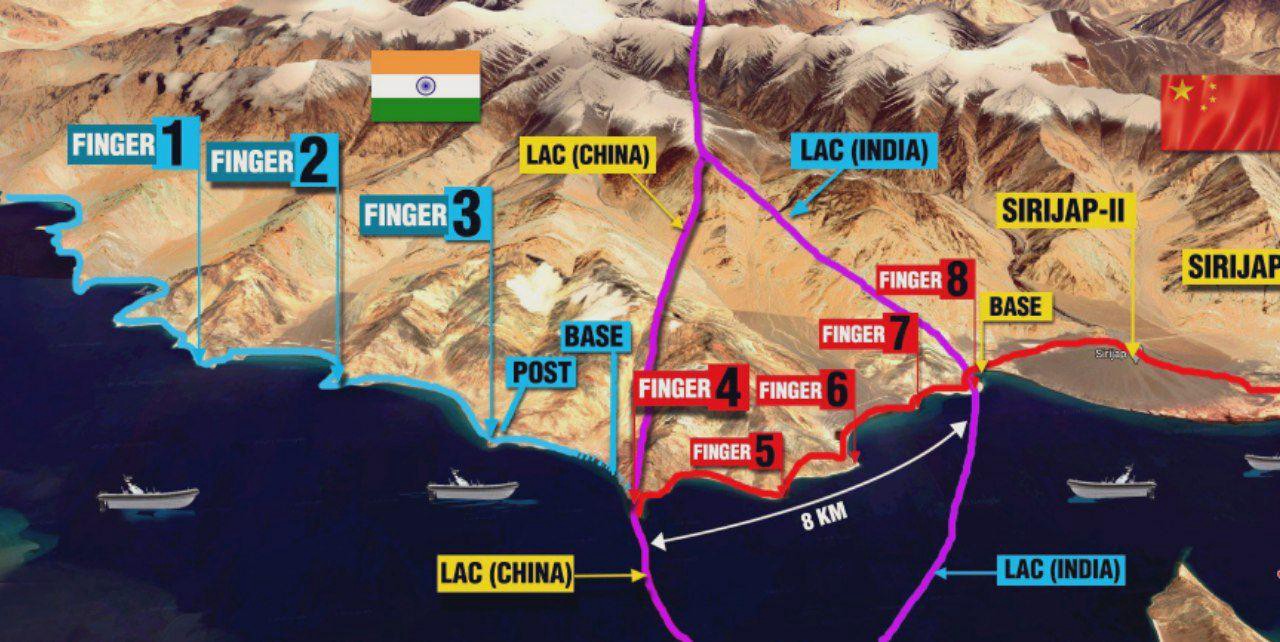Did India win the confrontation in Ladakh and, what it means for Pakistan
February 17, 2021 09:40 PM

Just a week ago, news media around the globe began broadcasting images and videos of Chinese and Indian army tanks driving away from seemingly nondescript, barren, desert-like hills that, at best, reminded one of Pakistan’s Skardu and Shigar area. Global media seemed very excited. A nine-month-long stand-off between nuclear-armed rivals, China and India, was coming to an end, they said. At the same time, India’s local media seemed to be in an especially celebratory mood. The Indian Army had successfully checked, what Indian media called, Chinese aggression and had thrown it back. China had been “out-foxed” and India had won the confrontation. Amidst all of this, there were a bunch of odd names – Dault Beg Oldi, Pangong Tso, Depsang Plains, Y-Juncture, Galwan Valley, et al – that were thrown about. Pakistanis had heard all these names before. Back when this confrontation had begun, our media had also thrown these names around – but without much context. At the time, the singular focus on our media had been our friend, China, which was portrayed as finally giving to the Indians what they deserved: A sound beating.
So, what is this clash? What happened? What are all these odd names? Did China “invade” Indian occupied territories? And then, what is this ‘disengagement’? Why are the tanks rolling back? More importantly, who won? Did India really win? And finally, what does all of this mean for Pakistan? Today, we will try to answer such questions and understand some of these issues which, only in June 2020, seemed poised to trigger nuclear war in South Asia.
Alright then, first the issue. As with Pakistan and India, and as with many other countries around the world, China and India have border disputes along their 2,000 KM+ boundary. Both sides claim certain areas and have different perceptions of their respective areas of control. Pertinently, this is true for the boundary between China and India-occupied Ladakh region in disputed Kashmir. As you go north and north-east in Ladakh, there are two key points of interest for us: A brackish-water lake called Pangong Tso and a dusty strip of land called Daulat Beg Oldi.
Of these, the brackish lake, Pangong Tso, is shared between China and Indian-occupied Ladakh. Two-thirds of it are in China. However, both countries dispute how much of the remainder lies with either. Here, the lake is overlooked by mountain ridges and mountainous formations that are colloquially called ‘Fingers’, since they seem to look like human fingers in satellite imagery. Now, these ‘Fingers’ are numbered – “Finger 01” being in Indian control and these build in count toward and into China, with the 8th “Finger” being in China proper. India claims the area all the way up to “Finger 08” whereas the Chinese maintain that they own the area up to “Finger 04”. The area between “Fingers 04” and “08” has been disputed. Traditionally, both sides have had their border security forces patrol the area by way of staking claim to it. There was the occasional wrangle between border forces of the two sides, but it hardly ever turned serious.
On May 5th, 2020, the Chinese military moved suddenly and took control of the entire disputed area. In addition, it moved forward on several other points, including areas called Galwan Valley, Hot Springs, Gurung Hill, Depsang Plains, among others. It is this action that triggered the nine-month confrontation and it is from the Pangong Tso area that the two armies are reported to be moving back.
So then, taking this as our point of departure, we have to ask: But why did the Chinese suddenly move into these disputed areas, such as Pangong Tso, Depsang Plains, et al? The answer to that rests with the other place I had stated previously that was important: Daulat Beg Oldi (henceforward, DBO). This place, DBO, is a dusty strip of land along the so-named Depsang Plains and comprises the northernmost settlement that India controls. More importantly, the Indians have built a mini airbase – referred to as an ‘Advanced Landing Ground’ – at DBO that can land medium transport aircraft such as C-130 Hercules and Antonov An-32. Naturally, this means that smaller fighters, bombers and helicopters can be stationed here. From the Chinese point of view, this forward mini-airbase has adverse strategic implications. That is to say, that in event of a conflict, Indian military can air supply its troops in the area and use the DBO airstrip to carry out operations against China across the adjoining Aksai Chin region in its Xinjiang and Tibet provinces. Equally for Pakistan, an operational DBO airbase helps India air supply its forces in the Siachen sector and launch airstrikes here.
Now, more ominously, beginning at a southerly town called Darbuk in Indian-occupied Ladakh, the Indians began to build an all-weather road northward to Shyok and then onward to DBO. This road was intended to link DBO with the city of Leh, which serves as an administrative capital to occupied Ladakh. However, now the Indians plan on extending the same road further northward into Depsang Plains and toward something called the Karakoram Pass. Here, the Karakoram Pass is a “tri-juncture” where India, China and Pakistan meet. Therefore, this one single road would make Indian Army operations south from Darbuk all the way to the Indo-China-Pakistan tri-juncture at Karakoram Pass, far more potent. It would connect the previously disjointed locations along this axis; pave way for more thorough operationalization of the DBO airbase; improve Indian access to the Depsang Plains (which, as the name suggests, is a flat territory through which Indian Army could drive its tanks straight into China’s Xinjiang and Tibet provinces!); and, finally, threaten Karakoram Pass, making any possible Sino-Pakistan joint military action against India all the more difficult.

Clearly then, something needed to be done about this. The Chinese had been consistently pressuring the Indians to halt construction. The Chinese had maintained that the road construction was escalatory and would destabilize the status quo in the area. There had been several other altercations between the two sides over the same issue, including major ones in 2013 and 2017.
Yet, the Indians did not budge and pressed on, especially so after the uber-nationalist, aggression-prone Mr Narendra Modi took power in New Delhi. Essentially irredentist as well as expansionist in worldview, the Modi government harbours aspirations for a so-called “Akhand Bharat” (or, ‘United India’). In this, it seeks to take, with force or otherwise, all territories it imagines as part of this “Akhand Bharat” ideal. It was the will to achieve this ideal that drove the Modi government to unilaterally absorb into the Indian Union the parts of the erstwhile state of Jammu and Kashmir that India was occupying. Naturally, the Aksai Chin region in China, claimed by India as its integral part, and to which this new road and the airbase at DBO afford access, no longer seemed too far down Mr Modi’s checklist.
Thus, conscious of such aspect of the Modi set up, watching an aggressive, irredentist nationalism rise sharply in India, and concerned about growing calls for Kashmir-like action elsewhere, the Chinese decided to move. In doing so, they mirrored Modi’s moves on occupied Kashmir and briskly took the areas China claims as its own. Interestingly, all the Chinese moves came in areas against the Darbuk-Shyok-DBO road and are designed to afford the Chinese some depth. That is to say, by ingressing into Indian-occupied territory, the Chinese have basically put in more area between themselves and possible Indian aggression. In other words, the Indians will need to cover more ground from their points of departure at the new road to get to China. At once, they have moved closer to the DBO airstrip, threatening to cut off Indian air operations here, should it come to it. Lastly, they blocked Indian access to the Depsang Plains, through which, as previously noted, the Indians could have hoped to drive tanks into China’s Xinjiang and Tibet.
All in all, then, the Chinese moves were defensive in nature. Even when moving to preempt the Indians against any future misadventure, the Chinese moved in response to continued Indian efforts to build their own military capabilities in the region. All of this comes after years of diplomatic efforts on China’s part to dissuade the Indians from their escalatory course.
So finally then: Did the Indians win the confrontation against the Chinese in Ladakh? As must have become quite clear by now, the answer is simply that they did not. Not at all. Firstly, the so-called ‘disengagement’ only comes at Pangong Tso. Here, the two militaries are moving their troops farther back to avoid any escalation on the ground. This leaves out pretty much all the other areas the Chinese moved into. The Chinese still hold, for example, Hot Springs further south. The Chinese still hold a formation called ‘Bottleneck’ or ‘Y-Juncture’ that is, to put it simply, the gateway to the entire Depsang Plains area. By controlling this point, the Chinese deny the Indians access to all of the strategic Depsang. In total, just over 900 square kilometres of area. This is true elsewhere as well.

Even if you look simply at the Pangong Tso area, the disengagement agreement says that the Chinese will move back to their old permanent base near “Finger 08” called Sirijap. However, more importantly, it has the Indians move to an outpost called Dhan Singh Thapa post. This, in fact, is beyond “Finger 03”. Note that the Chinese claim line extends to “Finger 04”. This means that the Indians will be moving back farther than the Chinese had originally asked of them. More poignantly, the agreement puts a total stop to any patrolling in the disputed “Finger 04 to Finger 08” area. If you think about it, this is a de facto acceptance of China’s claims in the area! The Indians have to move behind the area claimed by China and have lost access to the same, even as they could previously patrol it. Finally, built into the agreement, is the condition that the Indians will vacate all the forward posts they had built on commanding heights in the area as part of the confrontation. This includes posts they had built inside undisputed Indian-controlled territory! Why did they need to, is a question Mr Modi’s detractors are asking and will turn into a drama soon enough. In any case, an understanding of the finer points of this agreement makes, perhaps, the answer to the question of Indian victory quite self-evident.
So, at last, what does all this mean for Pakistan? Firstly, the Indians still hold DBO. They have, in fact, completed the road from Darbuk to DBO. China has secured its own interests but that does not take away from the threat that the DBO airstrip and the associated Darbuk-Shyok-DBO road poses to Pakistan. At Karakoram Pass. At Siachen. And throughout the adjoining regions. And, to make my second point I will only quote a tweet by noted Indian defence analyst, Mr Pravin Sawhney, to round off this discussion: “Question many asking me: Why has India’s agreed to vacate Kailash Range which falls on (Indian) side of (the boundary)?” he writes, “Because govt. wants to go back to its chosen enemy - Pakistan ASAP. China, more powerful, was consuming too much attention & was distracting Bakhts from core mission!”







 Public Holiday announced in Lahore tomorrow
Public Holiday announced in Lahore tomorrow Police claim girl seen in sub-inspector’s video was his second wife
Police claim girl seen in sub-inspector’s video was his second wife Nazish Jahangir to hit any marriage proposal from Babar Azam out of the ground
Nazish Jahangir to hit any marriage proposal from Babar Azam out of the ground Complete results: PML-N sweeps by-elections as PTI-SIC remains empty-handed in Punjab
Complete results: PML-N sweeps by-elections as PTI-SIC remains empty-handed in Punjab Iranian First Lady visits Numl
Iranian First Lady visits Numl Man shoots friend dead in DHA Karachi over personal grudge
Man shoots friend dead in DHA Karachi over personal grudge





